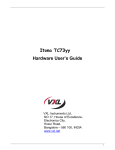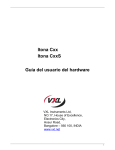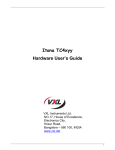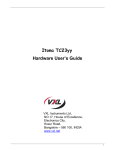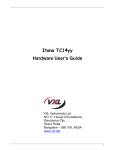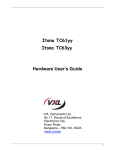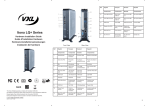Download Vxl Itona DxxS User`s guide
Transcript
Itona DxxS Hardware User’s Guide VXL Instruments Ltd, NO.17, House of Excellence, Electronics City, Hosur Road, Bangalore – 560 100, INDIA www.vxl.net 1 VXL Instruments Ltd. Itona DxxS Hardware User’s Guide Copyright and Trademark notices ALL RIGHTS RESERVED. Information in this document is subject to change without notice and does not represent a commitment on the part of the manufacturer. No part of this guide may be reproduced or transmitted in any form or means, electronic or mechanical, including photocopying and recording, for any purpose, without the express written permission of the manufacturer. Every effort has been made to make this guide as complete and as accurate as possible, but no warranty or fitness is implied. The authors and the publisher shall have neither responsibility nor liability to any person or entity with respect to loss or damages arising from the use of information contained in this guide. This disclaimer does not apply in countries where such provisions are inconsistent with local law. All Trademarks are acknowledged. Document Number: 600 0110 528 47 A00 First Edition: August 2010 Copyright and Trademark Notices 2 VXL Instruments Ltd. Itona DxxS Hardware User’s Guide Federal Communication Commission (FCC) Statement This equipment has been tested and found to comply with the limits for a Class B digital device, pursuant to Part 15 of the FCC Rules. These limits are designed to provide reasonable protection against harmful interference in a residential installation. This equipment generates uses and can radiate radio frequency energy and, if not installed and used in accordance with the instructions, may cause harmful interference to radio communications. However there is no guarantee that interference will not occur in a particular installation. If this equipment does cause harmful interference to radio or television reception, which can be determined by turning the equipment Off and On, the user is encouraged to try to correct the interference by one or more of the following measures: • Re-orient or relocate the receiving antenna. • Increase the separation between the equipment and receiver. • Connect the equipment to an outlet on a circuit different from that to which the receiver is connected. • Consult the dealer or an experienced radio / television technician for help. Each Thin Client is equipped with a FCC compliance label that shows only the FCC identification number. The full information of the associated label is as follows: This device complies with Part 15 of the FCC rules. Operation is subject to the following two conditions: 1. This device may not cause harmful interference, and 2. This device must accept any interference received, including interference that may cause undesired operation. Warning • DO NOT open enclosure, Hazard voltages present inside equipment. • Ensure that all expansion slots (on the back or side of the computer) are covered with metal retaining brackets, and tightly attached to the computer cabinet. • Only equipment certified to comply with Class B (computer input/output devices, terminals, printer’s etc.) should be attached to this equipment, and must have shielded interface cables. • Any changes or modifications not expressly approved by the party responsible for compliance could void the user's authority to operate this equipment. • This equipment should not be used in Electro-medical applications. • There are no user serviceable parts inside. DO NOT open enclosure, Hazard voltages present inside equipment. DO NOT disassemble the equipment as this can nullify your warranty • DO NOT operate this equipment in corrosive or explosive atmosphere. • DO NOT operate this equipment outside specified temperature limits. • This equipment must be earthed. • The AC socket outlet shall be installed near the equipment and shall be easily accessible. • Replace the Battery only with the same or equivalent type recommended by the manufacturer. • Sound Power Level is less than 60dB (A), when measured according to ISO 7779. • Excessive sound pressure from earphones and headphones can cause hearing loss. Adjustment of the equalizer to maximum increases the earphones and headphones output voltage and therefore the sound pressure level." FCC statement and Warning 3 VXL Instruments Ltd. Itona DxxS Hardware User’s Guide Preface Thank you for purchasing the Itona DxxS Series Thin Client. This guide contains information to setup and use the hardware of Itona DxxS Series. The guide consists of the following chapters: Preface • Introduction: provides an overview of the product. • Installation: contains the procedure to setup the hardware. • Specifications: provides hardware, mechanical, electrical, interface and operating environment specifications. • Connectors and Cables: provides detailed specifications for connectors and cables used with the product. • Troubleshooting: provides solutions to problems that you may encounter while using the product. 4 VXL Instruments Ltd. Itona DxxS Hardware User’s Guide Table of Contents Introduction ........................................................................................................................................6 Overview........................................................................................................................................................6 Features ........................................................................................................................................................7 Optional Features ..........................................................................................................................................7 Installation..........................................................................................................................................8 Step One: Unpack .........................................................................................................................................8 Step Two: Prepare.........................................................................................................................................8 Step Three: Connect accessories and power ...............................................................................................9 Step Four: Connect to the Server................................................................................................................11 LAN connection through TCP/IP ...............................................................................................................11 Direct Connection through RS232 ............................................................................................................12 Dial-In Remote Connection through a Modem..........................................................................................12 Specifications...................................................................................................................................13 Hardware .....................................................................................................................................................13 Mechanical ..................................................................................................................................................13 Environmental Operating.............................................................................................................................13 Electrical – External Power Adapter............................................................................................................13 Regulatory Certifications..................................................................................................................14 Connectors ..................................................................................................................................................15 COM Port...................................................................................................................................................15 10/100/1000 LAN Port...............................................................................................................................15 Video Port..................................................................................................................................................15 DVI Port .....................................................................................................................................................16 Mouse / Keyboard Port..............................................................................................................................16 Audio / Microphone Port............................................................................................................................16 USB Port 2.0..............................................................................................................................................16 Cables .........................................................................................................................................................17 10/100 LAN Cable .....................................................................................................................................17 COM Port (Serial Port) Cables ..................................................................................................................17 Troubleshooting ...............................................................................................................................19 Table of Contents 5 Itona DxxS VXL Instruments Ltd. Hardware User’s Guide Introduction Overview Thin Clients are essentially terminal devices that connect to multi-user application servers operating under Citrix MetaFrame and Windows 2000/ 2003 operating systems. This guide covers installation and hardware details of Itona DxxS Series. Power Button Smart Card Reader 2 USB Ports Itona DxxS Front View Itona DxxS Series deliver smart and robust solutions for Thin Client computing. They are aesthetically and ergonomically designed compact desktop, providing simultaneous full screen connectivity to Windows and UNIX application servers – a powerful business alternative to users using Win32 applications while continuing access to legacy UNIX applications. They communicate with application servers via the ICA protocol developed by Citrix Systems Inc., Remote Desktop Protocol from Microsoft and a host of other popular connectivity protocols. Please refer to the Software User’s Guide for information about connection protocols supported by your model. Introduction 6 VXL Instruments Ltd. Itona DxxS Hardware User’s Guide Features The product is equipped with a 10/100 /1000 Ethernet port that gives an instant connection to a multiuser Windows NT application server. Also provided are serial, parallel, VGA and DVI-I Ports. USB and PS/2 compatible keyboard/Mouse ports are available for quick setup and use. Optional Features • Smart Card reader • Wireless LAN • 3rd Serial Port Note: The optional features cannot be upgraded in the field. Please contact the reseller or dealer from whom you purchased the product for information about optional features. Introduction 7 VXL Instruments Ltd. Itona DXXS Hardware User’s Guide Installation This chapter describes hardware installation of the product. Step One: Unpack Unpack the unit taking care not to drop the product whilst removing from the packaging. The carton in which the product was shipped to you contains the following: • Itona DxxS Series Thin Client • AC – DC Power Adapter 12V / 5A • Pedestal Set • Power Cord ( Optional ) • DVI-I to VGA Cable ( Optional ) • Mouse (Optional ) • Hardware Installation Guide When you open the carton, if you find any discrepancy between the contents of the carton and the above list, contact the dealer or reseller from whom you have purchased the product, immediately. 9 NOTE: PLEASE RETAIN THE ORIGINAL CARTON AND PACKING MATERIAL. THEY WOULD BE REQUIRED TO AVOID DAMAGE DURING TRANSIT (IF REQUIRED IN FUTURE). Step Two: Prepare 1. The site where you want to install the product must have the following 2. • 9 100~240V AC, 1.2A, 50/60 Hz, 3-pin power Inlet for client (Itona DxxS). NOTE: ENSURE THAT THE POWER INLET PLUG IS PROPERLY REGULATED AND EARTHED. A FLOATING GROUND / CHASSIS COULD CAUSE AN ELECTRIC SHOCK. • Fix the pedestals at the bottom of the Itona DxxS. • Well ventilated, clean, dry and dust free atmosphere • Specified environmental conditions (refer to the section on specifications ) • Table or desk of suitable size. 3. Place the product on the table in a location that provides quick and easy access to the power Inlet plug to shutdown the power in emergencies. 4. Ensure a minimum space of 2 inches (5 cm) on all sides of the unit for efficient convection cooling. Installation 8 Itona DXXS VXL Instruments Ltd. Hardware User’s Guide Step Three: Connect accessories and power 9 NOTE: BEFORE CONNECTING ANY CABLES, ENSURE POWER CABLE IS UNPLUGED FROM THE UNIT. PLEASE USE 6A (MIN) / 250V AC 0.75 sq mm, H05VV-F CERTIFIED POWER CORD. Pictures below show the various connectors available on the rear panel of the client. 2-USB PORT EHTERNET PORT 2 – USB PORT COM PORT 2 COM PORT 1 COM PORT 1 VGA PORT VGA2 / DVI PORT PS/2 KBD PS/2 MOUSE PORT DC POWER IN 12V / 5A MIC COM PORT 3 AUDIO LINE OUT Itona DxxS Rear view Installation 9 VXL Instruments Ltd. Itona DXXS Hardware User’s Guide The table below identifies the devices to be used with each connector of the client. Instructions to connect various accessories 9 Connect the DVI cable from your display unit to the DVI port 9 Connect the video cable from your display unit to the video port 9 Connect USB devices to the USB ports 9 Connect external powered speakers to the audio output(LINE OUT) port 9 Connect an external audio device to the Microphone( LINE IN) input port 9 Connect microphone to the Microphone input port 9 Connect PS/2 keyboard to the PS/2 Keyboard port 9 Connect PS/2 mouse to the PS/2 Mouse port 9 Connect serial devices to the COM ports Connector Symbol DVI 1 9 Connect LAN cable to the RJ45 Ethernet port Caution: Ensure that COM1, COM2, COM3, VGA, and DVI Ports are adequately fastened with the screws provided with the cables. Installation 10 Itona DXXS VXL Instruments Ltd. Hardware User’s Guide Step Four: Connect to the Server The Thin Client can be physically connected to the server/network in three ways: • LAN connection through TCP/IP • Direct connection through RS232 • Dial-in remote connection through a modem LAN connection through TCP/IP Connect one end of a 10/100/ 1000 cable to the LAN port of the client. Connect the other end to a LAN hub as shown in the figure below. LAN Connection through TCP/IP Host 1 Workstation Host 2 Ethernet Winlinx Thin Client 10/100Base-T ICA Server Installation HUB 11 Itona DXXS VXL Instruments Ltd. Hardware User’s Guide Direct Connection through RS232 Connect one end of an RS232 cross cable to a serial port of the client. Connect the other end to a serial port of the server as shown in the figure below. Winlinx Thin Client Server COM PORT COM PORT RS232C CROSS Direct Connection through RS232 Dial-In Remote Connection through a Modem Connect one end of an RS232 straight cable to a serial port of the client. Connect the other end to a modem as shown in the figure below. RS232C STRAIGHT Server RS232C STRAIGHT COM PORT Thin Client Winlinx COM PORT PSTN Modem Modem Dial-In Remote Connection through Modem Press the power button to power up the Itona DxxS. The front panel LED lights up and the client boots up with a BEEP sound and takes you to the Connection Manager screen. Refer to the Software User’s Guide for configuring the client. Installation 12 Itona DXXS VXL Instruments Ltd. Hardware User’s Guide Specifications Hardware • Processor VIA C7-M ULV ™ nano BGA2 1.6GHz • VGA Memory: Shared Video Memory 32MB max • Flash : IDE 40 pin • RAM: 256MB ~ 2GB DDRII SODIMM 533/667MHz • Networking : 10/100/1000Mbps • Maximum Display resolution: VGA - 16/32 Bits 1920x1200 @60Hz max. DVI-I to VGA - 16/32 Bits 1920x1200 @60Hz max. OR DVI-I to DVI - 16/32 Bits 1920x1200 @60Hz max. • Power Supply : • Smart Card reader (Optional) • Wireless LAN • 3rd COM Port (Optional) External Power Supply (Optional) Mechanical • Height: 228 mm. • Width: 50 mm. • Depth: 230 mm. • Weight: 3.0 Kg (max) Environmental Operating • Temperature : + 5oC to +40oC • Storage temperature: - 20o C to +65oC • Humidity: 20% to 80% RH non-condensing Electrical – External Power Adapter • Line Voltage: 100V to 240V AC (+6, -10%) • Line Frequency: 50 / 60 Hz • Power Inlet: 1.2A, 3-pin power plug (IEC 320) • Power Out Put : 12Volts / 5A max Specifications 13 VXL Instruments Ltd. Itona DXXS Hardware User’s Guide Regulatory Certifications RoHS Regulatory Certifications 14 Itona DXXS VXL Instruments Ltd. Hardware User’s Guide Connectors and Cables Connectors The following tables provide pin details for various connectors on the rear panel of the client. COM Port 9-pin D-type male connector. RS232C compatible, operating at 115.2K baud maximum Pin Signal Description 1 1 DCD Data Carrier Detect 2 RxD Receive Data 3 TxD Transmit Data 4 DTR Data Terminal Ready 5 GND Signal Ground 6 DSR Data Set Ready 7 RTS Request To Send 8 CTS Clear To Send 9 NC Not Connected 5 6 9 10/100/1000 LAN Port RJ-45 modular 8-pin jack. 10/100/1000 Mbps 1 Pin Signal 1 TxD+ 2 TxD- 3 RxD+ 6 RxD- 8 Video Port 15-pin D-type female connector Pin Signal Pin Signal Pin Signal 1 Red 6 Red return GND 11 No Connection 2 Green 7 Green return GND 12 No Connection 3 Blue 8 Blue return GND 13 Horizontal Sync 4 No Connection 9 No Connection 14 Vertical Sync 5 GND 10 No Connection 15 No Connection Connectors and Cables 5 1 10 6 15 11 15 Itona DXXS VXL Instruments Ltd. Hardware User’s Guide DVI Port Pin C1 to C5 carry the analogue signal.24+ 5 pin DVI Connector. Pin Signal Pin Signal 1 TMDS Data2- 16 Hot Plug Detect 2 TMDS Data2+ 17 TMDS Data0- 3 TMDS Data2/4 Shield 18 TMDSData0+ 4 TMDS Data 4- 19 TMDSData0/5 Shield 5 TMDS Data 4+ 20 TMDS Data 5- 6 DDC Clock 21 TMDS Data 5+ 7 DDC Data 22 TMDS Clock Shield 8 Analog Vertical Sync 23 TMDS Clock + 9 TMDS Data1- 24 TMDS Clock - 10 TMDS Data1+ C1 Analog Red 11 TMDS Data1/3 Shield C2 Analog Green 12 TMDS Data3- C3 Analog Blue 13 TMDS Data3+ C4 Analog Sync C5 Analog Ground (analog R, G & B return) 14 15 +5 V Power Horizontal Ground(for+5V) Mouse / Keyboard Port PS/2 Mouse / Keyboard connector Pin Signal Pin Signal 1 Mouse / KBD data 4 VCC 2 NC 5 Mouse / KBD Clock 3 GND 6 NC 6 4 2 5 3 1 Audio / Microphone Port Standard audio jacks. USB Port 2.0 4-pin series-A receptacle. 4~ 5 ports depending on the model. Pin Signal 1 VCC 2 D- 3 D+ 4 GND Connectors and Cables 16 Itona DXXS VXL Instruments Ltd. Hardware User’s Guide Cables 10/100/1000 LAN Cable Cross Connection - (Without Hub) RJ45 Pin RJ45 Pin TXD+ 1 3 RXD+ TXD- 2 6 RXD- RXD+ 3 1 TXD+ RXD- 6 2 TXD- Straight Connection - (With Hub) RJ45 Pin RJ45 Pin TXD+ 1 1 TXD+ TXD- 2 2 TXD- RXD+ 3 3 RXD+ RXD- 6 6 RXD- COM Port (Serial Port) Cables Serial devices like modems and printers use 25 pin D-type connectors for RS232 connections. In order to connect an RS232 device with a 25-pin connector, 9-pin connector signals must be converted to 25pin connector signals as shown in the following diagram. 9-pin to 25-pin Cross Connection 9 Pin Connector (Thin Client) 25 Pin Connector TXD RXD RTS CTS DSR SGND DCD DTR 3 2 5 4 6 7 8 20 Connectors and Cables 3 2 7 8 6 5 1 4 RXD TXD CTS RTS DSR SGND DCD DTR 17 Itona DXXS VXL Instruments Ltd. Hardware User’s Guide 9-pin to 25-pin Straight Connection 9 Pin Connector (Thin Client) RTS DTR TXD GND DCD RXD DSR CTS Connectors and Cables 7 4 3 5 1 2 6 8 25 Pin Connector 4 20 2 7 8 3 6 5 RTS DTR TXD GND DCD RXD DSR CTS 18 Itona DXXS VXL Instruments Ltd. Hardware User’s Guide Troubleshooting This chapter contains solutions for problems you may encounter while using the product. Problem Solution • The Power-LED on front panel does not glow when the client is switched on. 9 Ensure that the power cord is plugged into an AC outlet. 9 Check the fuse in the power-plug, if available. • There is no display, though the power-indicating LED glows. 9 Ensure that the video cable is properly connected. • The mouse (or keyboard) does not work when the client is switched on. 9 Ensure that the mouse (or keyboard) is plugged into the correct PS/2 port on the rear panel Troubleshooting 19



















